Feeding your beloved canine companion wholesome, home-cooked meals is a rewarding experience, offering unparalleled control over ingredients and nutritional content. Preparing your own dog food can significantly reduce preservatives and additives, introduce a greater variety of high-quality ingredients, and ensure your dog enjoys every bite. This approach is particularly beneficial for owners who prioritize organic, reputable, and locally sourced components. Embarking on this journey allows you to create meals tailored precisely to your dog’s needs and preferences.
To truly master the art of homemade dog food, understanding the fundamentals of canine nutrition and safe preparation is paramount. This guide will walk you through the process, from selecting the right ingredients to portioning and storage, empowering you to provide your dog with the best possible diet. For those seeking specific recipes or dietary supplements, exploring options like soft dog biscuits for older dogs recipe or considering what is the best treat to give your dog can complement a homemade diet.
 Empress Qin looks on expectantly as homemade dog food is prepared.
Empress Qin looks on expectantly as homemade dog food is prepared.
Essential Components of Homemade Dog Food
The foundation of any healthy homemade dog food lies in a balanced combination of protein, carbohydrates, fats, vitamins, and minerals. When creating your own recipes, it’s crucial to research your dog’s specific nutritional requirements, as these can vary based on age, breed, activity level, and any existing health conditions. Consulting with a veterinarian or a certified canine nutritionist is highly recommended to ensure your homemade meals are complete and balanced, preventing potential deficiencies or excesses.
Protein Sources
Protein is vital for muscle development, repair, and overall bodily function. High-quality animal-based proteins should form the cornerstone of your homemade dog food. Excellent options include:
- Lean Meats: Chicken, turkey, beef, lamb, and pork are all excellent choices. Ensure they are cooked thoroughly to eliminate harmful bacteria.
- Fish: Salmon, sardines, and mackerel provide beneficial omega-3 fatty acids, which are great for skin, coat, and joint health. Always remove bones carefully.
- Eggs: A complete protein source, eggs are rich in amino acids and vitamins. They can be cooked or offered raw, though cooking is generally safer.
Carbohydrates and Fiber
Complex carbohydrates provide energy and essential fiber for digestive health. Good sources for homemade dog food include:
- Sweet Potatoes: Rich in fiber, vitamins (B6, C), manganese, and beta-carotene, sweet potatoes are fantastic for digestive well-being.
- Quinoa: This gluten-free ancient grain is a complete protein source and an excellent provider of essential amino acids. It should be offered in moderation due to its higher protein content.
- Brown Rice: A digestible carbohydrate that provides energy and fiber. Ensure it is cooked thoroughly.
- Oats: Another good source of fiber and energy.
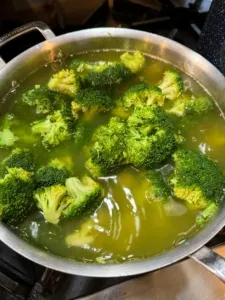 Broccoli florets being boiled until tender.
Broccoli florets being boiled until tender.
Vegetables for Vitamins and Minerals
Vegetables are packed with essential vitamins, minerals, and antioxidants, contributing to your dog’s overall health. Incorporate a variety of colorful vegetables into your dog’s diet:
- Carrots: Low in calories and high in fiber and vitamins, carrots are also beneficial for dental health when offered raw.
- Green Peas: A good source of thiamin, phosphorus, and potassium, peas should be cooked for easier digestion.
- Pumpkin: Excellent for digestive health, particularly for soothing upset stomachs. Ensure you use plain, cooked pumpkin puree, not pie filling.
- Broccoli: Rich in vitamins C and K, and fiber. Steam or boil until tender.
 Bright orange carrots, a nutritious and low-calorie treat for dogs.
Bright orange carrots, a nutritious and low-calorie treat for dogs.
Healthy Fats
Healthy fats are crucial for nutrient absorption, energy, and maintaining a healthy coat. Sources include:
- Fish Oil: A concentrated source of omega-3 fatty acids.
- Flaxseed Oil: Another plant-based source of omega-3s.
- Small amounts of olive oil or coconut oil: Can be added for palatability and added benefits.
Supplements and Additions
While a well-balanced homemade diet should ideally provide most nutrients, certain supplements might be necessary based on your dog’s specific needs. This can include:
- Calcium: Essential for bone health, especially if you are not including bone meal in the diet.
- Vitamins and Minerals: A good quality multivitamin designed for dogs can ensure all micronutrient needs are met.
- Yogurt: Plain, unsweetened yogurt (especially Greek yogurt) can be a good source of probiotics for digestive health. Many dogs, despite being lactose intolerant, can tolerate yogurt well. The whey from yogurt is also highly nutritious.
 Frozen peas being added to a mix of cooked vegetables.
Frozen peas being added to a mix of cooked vegetables.
The Preparation Process: Step-by-Step
Creating homemade dog food is a process that requires careful planning and execution. By following these steps, you can ensure a safe, nutritious, and appealing meal for your canine companion.
Step 1: Ingredient Selection and Preparation
Begin by selecting high-quality, fresh ingredients. Wash all vegetables thoroughly and trim any excess fat from meats. Cook meats, grains, and vegetables thoroughly. For meats, this means cooking them until no pink remains. Grains like quinoa and rice should be cooked until tender. Vegetables can be steamed, boiled, or lightly sautéed until soft enough for your dog to digest easily. Avoid using seasonings, onions, garlic, or excessive salt, as these can be harmful to dogs.
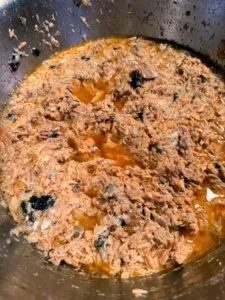 Cooked salmon, with a note to carefully check for bones.
Cooked salmon, with a note to carefully check for bones.
Step 2: Combining and Processing
Once your ingredients are cooked and cooled, it’s time to combine them. You can mix them by hand in a large bowl or use a food processor. Many owners find that processing the food to a finer consistency, rather than leaving large chunks, is preferred by their dogs, making it easier to eat and digest. This step also helps to ensure a more uniform distribution of nutrients.
 Various prepared food components being placed into stainless steel bowls.
Various prepared food components being placed into stainless steel bowls.
Consider the texture your dog prefers. Some dogs enjoy a chunkier meal, while others do better with a smoother consistency. If you are introducing new ingredients, start with small amounts to gauge your dog’s reaction and ensure there are no digestive issues. For those exploring different dietary options, understanding what is the best food to make for your dog can provide further inspiration.
Step 3: Portioning and Storage
After the food is prepared and processed to your dog’s liking, it’s time to portion it. Using individual containers, such as quart-sized ones, makes feeding time convenient. A production-line approach can make this step efficient, especially when preparing large batches.
 A large quantity of prepared food components, including venison and vegetables.
A large quantity of prepared food components, including venison and vegetables.
Label each container with the contents and the date it was prepared. This is crucial for tracking freshness and managing your dog’s diet. If you plan to freeze portions, fill containers only up to the first line to allow room for expansion during freezing. Properly stored homemade dog food can be kept in the refrigerator for 3-4 days and in the freezer for several months. Always thaw frozen portions in the refrigerator before serving.
 Sweet potatoes, highlighted for their fiber content and digestive benefits.
Sweet potatoes, highlighted for their fiber content and digestive benefits.
Serving Your Homemade Dog Food
When it’s time to serve, combine the homemade food with your dog’s regular kibble or serve it as a standalone meal. Adding a small amount of plain yogurt or the reserved whey can add moisture and probiotics, enhancing palatability and digestive health.
 Quinoa, described as a gluten-free superfood with high protein content.
Quinoa, described as a gluten-free superfood with high protein content.
Many dogs eat two meals a day, which is beneficial for their digestion. Splitting their total daily intake into two servings can prevent discomfort and aid in nutrient absorption. Always ensure your dog has access to fresh, clean water at all times.
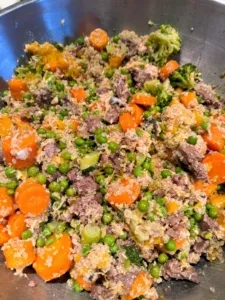 The mixed ingredients appear appetizing before being processed.
The mixed ingredients appear appetizing before being processed.
Transitioning to Homemade Food
When transitioning your dog to a homemade diet, do so gradually over a period of 7-10 days. Start by mixing a small amount of homemade food with their current food, slowly increasing the proportion of homemade food while decreasing the commercial food. This gradual approach helps prevent digestive upset. Monitor your dog for any signs of allergies, sensitivities, or digestive issues during the transition.
 Elvira Rojas mixes processed homemade dog food before packaging.
Elvira Rojas mixes processed homemade dog food before packaging.
Important Considerations and Warnings
While making homemade dog food offers numerous benefits, it’s essential to be aware of potential pitfalls and safety concerns.
Avoid Harmful Ingredients
Certain foods that are safe for humans can be toxic to dogs. Always avoid:
- Onions, Garlic, Chives, and Leeks: These can damage a dog’s red blood cells, leading to anemia.
- Grapes and Raisins: Can cause kidney failure.
- Xylitol: An artificial sweetener found in many sugar-free products, highly toxic to dogs and can cause liver failure.
- Chocolate: Contains theobromine, which is toxic to dogs.
- Alcohol and Caffeine: Should always be avoided.
- Cooked Bones: Can splinter and cause internal damage.
Ensure Nutritional Balance
The biggest challenge with homemade dog food is ensuring it’s nutritionally complete and balanced. A diet lacking essential nutrients can lead to long-term health problems. Always consult with a veterinary professional or a canine nutritionist to create a diet plan that meets your dog’s specific needs. They can help you formulate recipes that include the right proportions of protein, fat, carbohydrates, vitamins, and minerals. For instance, if you are preparing food for puppies, understanding what is the best treat for puppy training is also important for their overall development.
 Quart-sized containers filled with prepared dog food, ready for storage.
Quart-sized containers filled with prepared dog food, ready for storage.
Food Safety
Practice good food hygiene when preparing homemade dog food. Wash your hands thoroughly before and after handling ingredients. Clean all utensils, cutting boards, and surfaces that come into contact with raw meat. Cook all ingredients thoroughly to kill potential pathogens. If you are concerned about pests or fleas, learning about natural flea and tick repellent for dogs homemade can be a good addition to your holistic pet care routine.
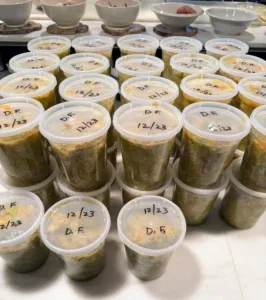 Labeled containers of homemade dog food, ready for freezing or refrigeration.
Labeled containers of homemade dog food, ready for freezing or refrigeration.
Conclusion: The Joy of Homemade Dog Food
Preparing your own dog food is a labor of love that offers significant benefits for your dog’s health and well-being. By focusing on high-quality ingredients, proper preparation techniques, and ensuring nutritional balance, you can create delicious and healthy meals that your dog will adore. Remember that consistency and careful planning are key to success.
 A single container of finished homemade dog food, ready to be served.
A single container of finished homemade dog food, ready to be served.
Always prioritize your dog’s individual needs and consult with veterinary professionals to ensure your homemade diet is complete and balanced. The dedication you put into preparing these meals will undoubtedly be rewarded with a happier, healthier, and more vibrant canine companion.
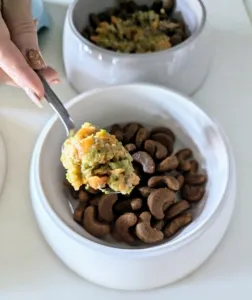 A bowl of kibble being mixed with homemade food and yogurt.
A bowl of kibble being mixed with homemade food and yogurt.
If you’re interested in exploring more about dog nutrition and care, we have a wealth of information on our site.
References
- American Veterinary Medical Association (AVMA) – Pet Food Guidelines
- Veterinary Partner – Homemade Diets for Dogs
